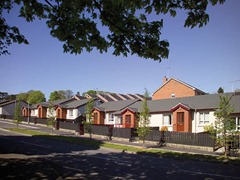Homelessness in Northern Ireland
3rd April 2014Service and savings: the ALMO model
16th April 2015The review revisited
 As debate on the future of housing delivery continues, agendaNi revisits the independent review of the Housing Executive and its findings.
As debate on the future of housing delivery continues, agendaNi revisits the independent review of the Housing Executive and its findings.
The fundamental review of the Housing Executive, commissioned by then Social Development Minister Alex Attwood in October 2010, was the first comprehensive appraisal of its remit since it was established in 1971. The final report was published in June 2011 with the aim of scoping out “the role and the future of the Northern Ireland Housing Executive over the next 20 years.”
This review was undertaken by PwC and was therefore separate from the governance audit being carried out by the Department for Social Development at the same time, which focused on unauthorised land disposals, and related police investigations into alleged fraud.
PwC described the Housing Executive as “one of the success stories from Northern Ireland’s recent history” having transformed Northern Ireland’s social housing from almost “one of the worst in Western Europe to … best quality stock.” It also managed to maintain the confidence of all sides of the community despite working in the most deprived and divided areas of the province.
However, its everyday work of as a social landlord – the largest in the UK – had created a “gravitational pull” which limited its ability to look at strategic issues. The review’s overall vision for social housing had four main aspects:
1. a focused and innovative policy function;
2. a strong independent regulator function for all housing tenure types;
3. a strategic function with a holistic view of housing and responsibility for key public sector-initiated programmes; and
4. an effective and efficient landlord function.
Policy would continue to be set by the Department for Social Development.
The ‘housing regulator’ would have around 30 staff and have running costs of around £1 million per annum. It would take on the governance and inspection work currently carried out by the Department for Social Development and would also independently set rent levels for landlords in social and affordable housing. Ministers would therefore no longer have the power to influence rent increases.
A larger ‘strategic housing authority’ would have around 460 staff with annual costs of £263 million, excluding loan repayment charges and inflation. Additional staff and costs could be added in order to implement the UK Government’s universal credit system.
The authority would continue to ultimately own the existing Housing Executive stock, develop a holistic housing strategy, independently assess housing need, promote energy efficiency, provide services for the homeless, and commission and monitor social housing programmes.
Finally a new ‘social enterprise landlord’ would have leasehold ownership of the authority’s stock and be responsible for maintenance, community cohesion and safety. It would employ 1,400 staff, have a budget of £260 million and be established as company limited by guarantee with charitable status, governed as a mutual owned by tenants.
PwC acknowledges the risk that Protestant and Catholic tenants could choose political activists to stand up for their community’s perceived interests on the board of the social enterprise. This would damage the political independence that the Housing Executive has prized since its establishment and result in political rather than impartial decisions.
The public sector would “no longer be able to direct or control specific decisions” taken by the landlord body and elected politicians were likely to have “significantly less influence” over how it operated. As long as it met its legal and regulatory obligations, the landlord would be free to operate in the same way as any other business.
The Housing Executive currently has around 3,000 staff and a budget of £166 million for 2014-2015. It will also pay out another £120 million in capital expenditure to housing associations over the incoming financial year.
The three new structures would have 1,890 staff and a minimum annual budget of £524 million. As the landlord body would be self-funding, public finance would account for £264 million of this budget. In the long term, PwC predicted that this model would deliver the £5.5 billion investment in housing maintenance suggested by the Savills review.
A culture change is also needed in order to ‘join up’ services. This would involve a network of ‘jobs, housing and benefits offices’ and the transfer of some frontline housing-related services to local government.
Under the Review of Public Administration, the new councils will become responsible for registering houses in multiple occupation and issuing repair and demolition notices for unfit dwellings.
PwC emphasised that all of its recommendations and suggestions were “subject to the discussion and validation” of its working assumptions. The subsequent debate needed to involve Housing Executive staff and tenants, and other interested parties, and be part of a “mature conversation” about the future of social housing.
The review authors noted that their preferred solution was not financially the most beneficial option for the public sector – the best financial choice was to sell off the stock to the housing associations. They concluded, though, that their proposals provide “the best balance between the interests of tenants, staff, citizens and taxpayers.”
Key questions
• Should Housing Executive and housing association rents converge?
• What is the best way to ensure the regulator’s political independence?
• Should the department take on the strategic authority role?
• Is there enough political will to move the landlord function outside the public sector?
• Could the landlord become politicised by party nominees elected by tenants?
• How many ‘joined up’ benefits offices are needed (and where)?
Future options for delivery
| Option | Net required contribution | Potential savings |
| Do nothing | £955 million | None indicated |
| Do minimum (increase maintenance budget) | £1.87 billion | None indicated |
| New structures but Housing Executive as landlord | £1.16 billion | £704 million |
| New structures and social enterprise landlord (leasehold from government)* | £1.48 billion | £388 million |
| New structures and social enterprise landlord (concessionary arrangement) | £1.26 billion | £608 million |
| New structures and stock transferred to housing associations | £397 million (surplus) | £2.27 billion |
| New structures and stock transferred to private sector (as managing agent) | £1.26 billion | £608 million |






